Every person in the world has at least a few moles on their body. Some people have quite a lot of moles on their body, however, these familiar formations are the norm and do not raise questions until they begin to increase in number or size.
A mole or nevus is a skin formation that appears as a result of melanocyte cell division. Moles can range from light beige to almost black.
In addition, there are vascular moles - they are clusters of blood vessels on the surface of the epidermis and are colored pink and red.
Causes of moles
An interesting fact is that children are born with almost perfectly clear skin (not counting possible birthmarks). Moles begin to form after the first months of life, and this process continues into adulthood..
What are the main reasons for the appearance of moles on the body:
Scientists cannot give a definite answer to the question “why there are many moles on the body,” but there are the most likely reasons:
- Heredity.
- Hormonal changes in the body.
- Radiation influence.
- Abuse of solarium and tanning in direct sunlight.
Often close relatives can have identical moles that are located in the same place. The hereditary factor is quite a common phenomenon; genes have such a complex mechanism that even the location of a mole is subject to them.
Absolutely all people undergo hormonal changes in the body during puberty. In women, hormone surges continue during menstruation, pregnancy, the postpartum period and menopause.
The fact is that the pituitary gland at certain periods begins to produce hormones that stimulate the formation of melanin. In those places where its concentration is increased and moles appear.
Working in hazardous industries and factories, where the level of radiation is increased, also affects the body. The skin may behave completely unpredictably and, among other side effects, many moles may appear on the body, and old moles may enlarge or develop into tumors.
Fans of natural sun tanning and artificial tanning in a solarium should remember that active exposure of the skin to light radiation causes the epidermis to turn on the protective mechanism and produce melanin in large quantities, which means the appearance of many new moles is inevitable.
Moreover, active sunbathing and moles on the body are generally incompatible concepts, since any irradiation can lead to the growth of a nevus and its modification to the state of a tumor. Of course, there is a recommendation to simply cover large moles on the body before sunbathing, but in practice this is of little use, since the tan will be uneven and “spotty”.
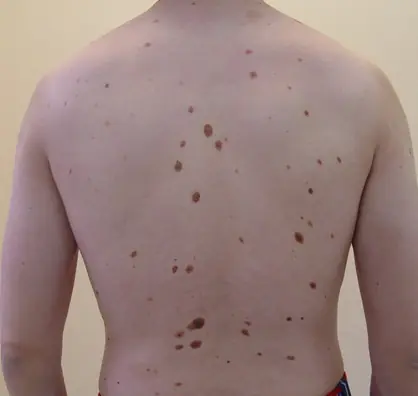
What is the danger of having many moles on the body?
If nevi appear quite often and also grow, these are clear reasons to visit a dermatologist or dermato-oncologist. It is necessary to conduct a visual inspection of the nevi and possibly take a scraping or part of the mole for analysis to identify the causes of the changes. A sample of the mole is sent for a laboratory test called histology, where an experienced doctor will examine the tissue under a microscope to determine whether it contains dangerous cancer cells.
If cancer cells are not detected, you must:
- undergo hormone testing;
- donate blood for analysis;
- In some cases, an MRI scan of the brain may be needed to study the pituitary gland.
If cancer cells are detected, the stage of the disease is determined (there are 4 in total) and a decision is made to remove the mole and further treatment. Treatment includes a thorough examination of neighboring nevi and lymph nodes located nearby. The fact is that cancer cells can spread extremely quickly and affect neighboring skin formations, the lymphatic system and nearby organs.
In addition, they can spread throughout the body through the bloodstream; unfortunately, this stage is no longer treatable. In later stages, chemotherapy and radiation therapy are used, alternatives to which science has not yet come up with.
What to do if many moles appear on your body
If there are a large number of moles, especially if they are large, convex or hanging on a so-called stalk, you need to take precautions so as not to injure the nevi.
- When visiting the shower, you should use only soft washcloths.
- You need to wear loose clothing that will not rub or injure those areas of the skin where the nevi are located.
- Keep your nails short to avoid accidentally scratching or tearing off moles.
You definitely need to keep an eye on the moles themselves:
- Does size and shape change;
- Does the color change?
- Is there any peeling or cracking on the mole?
If multiple moles cause significant discomfort, if there is a threat that they will come off or if they spoil the aesthetic appearance, then you can have the moles removed by a specialist.
Moles are removed in several ways:
- Laser;
- Surgically;
- Liquid nitrogen;
- Electrocoagulation.
Removal is generally painless, after the procedure there is a small scar that disappears over time.
To avoid various troubles associated with moles, you need to know the general reasons for their modification, carefully monitor the most vulnerable neoplasms, and it is better to remove the most dangerous nevi for preventive purposes.
Moles are benign formations on human skin. The localization of such neoplasms can be very diverse: they can be located on any part of the body and face. If you notice that you have many new moles on your body, then there is no need to panic. From this article you will learn about the reasons for the appearance of moles on the body, as well as their meaning.
Warning: mole
All pigmented moles are considered benign neoplasms and in 90% of cases, they never degenerate into something more terrible. However, it is worth protecting them from damage and exposure, including exposure to the sun. You should pay attention to the following points if:
- suddenly many moles appeared on the body.
- the edges of the nevus become uneven;
- the color of the spot changes;
- the mole quickly grows in width or upward;
- the skin on it cracks, hurts, itches.
Laser mole removal is fairly safe. But doctors believe that if a mole does not bother you and sits tightly on the body, then it is better to leave it alone. Moles are often removed on the collarbones, where they can be easily torn off or rubbed by a bra strap or handbag, as well as on the arms, legs, and lower back.
To reduce the risk of nevi degenerating into cancerous tumors, after 30 years of age, limit trips to the solarium and try to spend less time in the open sun. Sunscreen is required before going to the beach and after swimming. Cosmetics with ultraviolet filters will prevent the appearance of moles on the face in winter.
What is a mole
A mole is a pigmented formation on the skin. It occurs by overcrowding cells with melanocytes. In other words, a mole appears in a place where the accumulation of melanocytes is too high. The medical name for a mole is nevus. Nevus is absolutely not dangerous, since it is a benign formation.
If you notice any unusual changes, it is best to consult a dermatologist immediately. Sometimes a mole can develop into a malignant one, but this is very rare. This formation is called melanoma. This is a type of cancer that develops very rapidly and has quite serious consequences.
Why moles appear
Most moles appear at the age of 10 years. There are cases when a child is born with moles. This is a rare but completely normal occurrence. It is believed that moles appear during the period of hormonal changes in the body.
Women are more susceptible to hormonal changes than men. This is why females have more moles. Also, women often have moles on the mucous membranes. Moles may appear during pregnancy, and this is quite normal.
The appearance of moles is very common in pregnant women. Most mothers in this case run to the hospital for help or look for salvation on the Internet or reference books. To solve the problem, it is enough to find out what a mole is and why they appear.
Factors contributing to the appearance of new moles
It must be said that there are people whose bodies are covered with many moles. There are others who have virtually no moles. Newly born babies do not have pigmentation, and only with age, usually in the second year of life, moles appear. Nobody usually pays attention to the first moles - they are so invisible.
At the age of puberty, new moles appear. For some people, old moles only change during a hormonal surge. The increase in the number of moles is influenced by changes occurring in the body. In addition, moles can change color, size, become darker or brighter.
Pregnancy can also provoke the appearance of new moles. Direct sunlight contributes to the appearance of moles on the body.
What is a mole
A mole is a pigmented formation on the skin. It occurs by overcrowding cells with melanocytes. In other words, a mole appears in a place where the accumulation of melanocytes is too high. The medical name for a mole is nevus.
Nevus is absolutely not dangerous, since it is a benign formation. If moles on the skin do not bother or cause discomfort, then there is nothing wrong with it. Even if there are very large numbers of moles on the body. If a mole suddenly begins to grow, itch, bleed, or change color, then this should alert you. If you notice any unusual changes, it is best to consult a dermatologist immediately. Sometimes a mole can develop into a malignant one, but this is very rare. This formation is called melanoma. This is a type of cancer that develops very rapidly and has quite serious consequences.
Interesting and important facts
When a woman is pregnant, she experiences a crazy surge of hormones during lactation. This is a consequence of the fact that during pregnancy the body works for two, which is a lot of work for it. Hormones that are produced in double volume come to the rescue. This helps to cope with the load. The appearance of moles during pregnancy indicates that the hormonal system is working perfectly. Sometimes nevi disappear after a while, but this is not a reason to panic. More often than not, they last a lifetime and remind you of a wonderful time in your life.
It is worth paying attention if moles that appear during pregnancy begin to bother you. In principle, this applies not only to new but also to old formations. If you notice a change in color, swelling, itching or burning, consult a specialist immediately. This often happens in pregnant women due to hormonal explosions. After childbirth, everything falls into place. Such places must be carefully monitored so as not to cause harm. Try to avoid exposure to ultraviolet rays on these areas, do not scratch or press.
A specialist will help you understand the cause of discomfort. Alternatively, your doctor may suggest removing the mole to avoid the risk of developing melanoma. But this is already an extreme case. Often, pregnant women develop moles, but most often doctors do not remove such formations so as not to bother the mother and baby.
Why are there many moles on the body?
There are several reasons, and each of them is expressed in the characteristics of the human body. Such factors as astrology, esotericism, and the character of a person have absolutely nothing to do with it. Just an organism. So, most often people who have fair skin have a lot of moles. It contains a little melanin, and it does not spread throughout the skin, but is concentrated at certain points.
They are pigment spots. The second reason for the prevalence of moles is liver disease. At the same time, it is not necessary for the liver to hurt: it can be destroyed completely unnoticeably. The third significant reason is the incorrect distribution of human energy. If he is angry too much or, conversely, sad too little, being constantly cheerful and welcoming, his energy meridians are disrupted, causing moles to appear on the skin for the first time already in a person’s conscious age. These, in fact, are all the possible reasons for the massive appearance of birthmarks.
What does the appearance of new moles mean?
Moles are considered benign formations, regardless of whether they are congenital or acquired. But what is the reason for the appearance of new moles? Sometimes it is simply impossible to understand this issue - it is so difficult to trace the factor that provoked the appearance of the neoplasm. In any case, if you have a lot of moles on your body, there is no need to panic.
However, it is known that there are no places on the body where a new mole cannot appear, including the mucous membranes.
The appearance of new moles does not necessarily indicate the presence of a symptom of their malignant degeneration. In fact, the latter does not depend on quantity, but depends on condition. If a mole has changes - redness, swelling, hardening, soreness, itching, change in shape - these symptoms may be a cause for concern. In most cases, the transformation of a mole into melanoma, that is, into a malignant mole, occurs due to the fault of its carrier: for example, a person accidentally injured it, or constantly removed hair from the mole, etc.
Why did a red mole appear?
A red mole consists of many microscopic vessels. It can appear, as a rule, on any part of the body. Most often, red moles occur in young children and adolescents. Perhaps because it is in childhood that the human circulatory system undergoes certain changes. Often, red moles appear on the body of adults after prolonged exposure to the sun. They can be located in different layers of the skin and in different parts of the circulatory system: arterial, capillary or venous. Treatment depends on the location of the moles.
There is no need to worry about the appearance of red moles. Most of them can appear quickly and disappear just as quickly. Only a non-standard, rapidly growing mole that changes color can be a cause for concern.
In medicine, a red mole is called an angioma. It belongs to the category of safe skin diseases. Currently, the appearance of red moles has not been fully studied and there are only assumptions as to the main reason for their origin. A red mole has one main feature: when lightly pressed on it, it becomes pale, and then returns to its original natural color.
It is believed that the cause of the appearance of red moles on the body of an adult may be hormonal changes occurring in the body.
Therefore, if a red mole appears on your body, you should think about a preventative visit to the doctor. Perhaps the alarm will turn out to be false, but in cases with your own health, it is always worth being on the safe side. Also, the cause of the appearance of a red mole may be excessively intense work of blood vessels, or a deviation in the functioning of pigment cells responsible for skin pigmentation.
Many moles - is it good or bad?
In fact, there is nothing good about having too many moles. There are many legends that: a person who has many birthmarks will become happy; such a person is spiritually multifaceted and intellectually gifted; moles attract good luck and repel bad luck... There are a lot of options, but all of this is just wishful thinking. In fact, there is nothing good about a large number of moles. On the contrary, British scientists have recently proven that an abundance of age spots doubles the risk of developing skin cancer for their carrier.
The same pair of genes in the human body is responsible for both the formation of moles and the risk of developing cancer. People who do not have a large number of birthmarks do not have a trace of any of these genes. Thus, you need to fight the abundance of moles, so to speak, from the inside.
However, they have one advantage. Quite a dubious plus, I must say, but scientists seem to have proven it. The fact is that a huge number of birthmarks have a beneficial effect on a person’s biological age, reducing it by 5-7 years. As a result, people with nevi are more active and internally young. Even if this theory has a scientific basis, it is unlikely that its results should be taken as an axiom. It is unlikely that they apply to everyone.
What do moles mean?
There are many signs associated with spots on the body. In some places this is a good sign, in others it is a warning. Turgenev in his story “Mumu” mentions that “moles on the left cheek are considered in Rus' to be a bad omen - a harbinger of an unhappy life.” In India, it was also believed that having moles on the left side of the body was bad for a woman, but good for a man.
Otherwise, the location of moles was largely interpreted quite literally:
- Moles on the head signified the degree of a person’s influence on others and his resistance to fate.
- Moles hidden by hair gave supernatural powers.
- Dark signs on the feet meant a desire to travel and a frequent change of place of residence.
- Markings on the calves are a sign of jockeys, circus performers, dancers who have a strong will, but a vulnerable soul.
- Moles on the stomach served as a sign of bad nature: craving for bad habits, promiscuity in sex. It also mattered what organ the sign was located over and what size it was.
- The signs on the back promised a righteous lifestyle, but poor health.
- On a woman's breast, small spots characterized the owner as a good mother and wife, but under the breast - as a fatal temptress.
A small brown mole on the palm had many meanings. On the Saturn line it meant a difficult fate, but right in the center, on the contrary, a happy married life. On the life line - health problems, at the base of the thumb - infertility and other problems with childbirth. Under the little finger, the forecast was more favorable: immediately below the base of the finger - success in business, and below - success in relationships.
Wherever moles are located, it is better not to pay attention to bad omens. Let them be symbols of your beauty and uniqueness.
What to do if many moles appear on the body
It is worth saying that a large number of moles in itself is not a reason to panic. Especially if they have been on the human body since childhood. It makes sense to worry if there are gradually more and more of them, because this is the first sign of possible melanoma.
To prevent benign formations from becoming malignant, they need to be “preserved.” It is not at all necessary to remove moles, it is enough just to stop their constant appearance. Fortunately, nowadays this can be done in many ways:
- using special soap, which can be bought at most pharmacies;
- using simple tar soap, although it does not help every person;
- by applying various creams and ointments to the skin;
- taking appropriate vitamins, such as D3;
- just trying to keep my endocrine system healthy.
And if moles begin to make themselves felt unpleasantly, you need to urgently run to an endocrinologist. Swelling, deformation and itching are the main factors to pay attention to. If at least one of them comes true, you cannot hesitate. After all, melanoma arises precisely from such symptoms, which means that they must be carefully avoided.
Bleeding will almost certainly occur, and on top of this, it is quite possible that there will be blood poisoning. Then it will be very difficult to deal with the surging problems, especially realizing that you yourself are to blame for everything. So for treatment of swollen or itchy moles, you should contact only a professional endocrinologist.
A person has at least one mole, but some have up to 600. Is this good or bad and why did many moles appear on the body completely unexpectedly? Researchers have found that people with multiple moles have younger-looking skin and better bone density, leading to delayed aging. People think that a mole-shaped birthmark can be very beautiful, but it turns out that it may very well keep you looking younger for longer because the skin cells with moles have properties that allow them to renew themselves more often, and this is a proven fact.
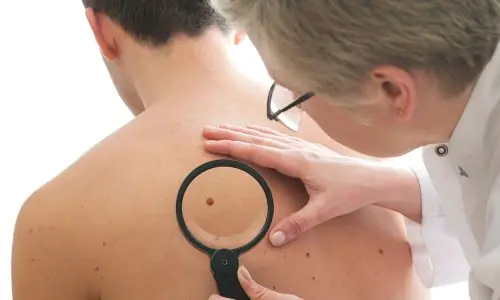
But there is a price that may have to be paid for this delayed aging. A large number of moles is significantly associated with a higher incidence of cancer compared to other skin types. People with cell divisions and a more youthful appearance may have an increased risk of developing cancer.
Dr Bataille, a leading researcher who presented his findings on the issue at Britain's Royal Society of Medicine, said: 'When a patient comes to me with multiple birthmarks, I automatically start to find out their family history of cancer, and I immediately start thinking about prevention. "It's not just melanoma, but also more common cancers like breast cancer and colon cancer."
But there is also good news!
And it's that people with birthmarks have proven to be less vulnerable to some of the effects of skin aging, such as wrinkles and age spots. Also, a recent study of 1,200 twins found that having more moles on the body means these people are less susceptible to age-related decline in bone density, which could mean a lower risk of developing brittle bones and fractures in old age. People with more than 100 moles on their body are half as likely to develop osteoporosis as those with 25 moles or fewer.

The reason for this is not fully understood, but researchers have noticed that people with birthmarks have differences in the strands of DNA that carry the genetic code in the body's cells. The sections at the ends of these threads are called telomeres, and they are an effective countdown timer that regulates how many times a cell can divide and produce new cells. The longer the telomeres, the more cell divisions can occur throughout life. And a large number of birthmarks are always associated with longer telomeres. Perhaps nanoperforation or microneedling can help solve this problem.
Based on this study and the results obtained, Dr. Bataille proposed that birthmarks are an external manifestation of the system that controls the aging process. When you look at people who have a lot of birthmarks, you will notice that they look better as they age.
Nevus is generally harmless
Most moles are harmless and there is no reason to remove them, but many people who have moles on their face find them unattractive and want to have them removed for cosmetic purposes. Facial moles tend to receive more attention than moles elsewhere on the body. In the 1950s, a dark mole on the cheek was considered a very attractive attribute, and girls often drew artificial nevi on their faces with a pencil. Back in the Middle Ages, they were called flies, and the fashion for them either goes away or comes back again. Cindy Crawford brought it back again with her signature birthmark on her face near her mouth.
Birthmarks are small, dark growths of skin that develop from pigment cells that produce melanin in the skin, but they can be flesh-colored or yellow-brown, they can also be raised above the skin and very noticeable, and they can also grow dark hair. In general, hair on a mole does not make it more dangerous. It is the content of the melanin pigment that causes the brown color of most birthmarks. And if you start to have a lot of moles on your body, it means that the process of intensive reproduction of these very cells that produce and accumulate melanin has begun in your skin. 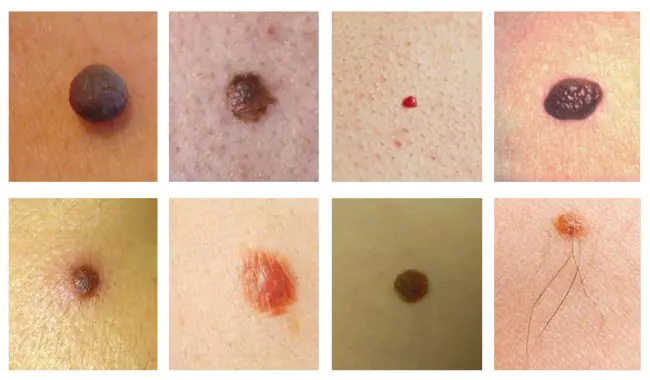
Check out these formations
All birthmarks should be checked regularly. While it's easy to notice moles on the face (because we tend to regularly look at our faces in the mirror), moles in other places can easily be forgotten or overlooked. If you are interested in maintaining your health and prolonging your life, then if you have many moles on your body, immediately go to a dermatologist or personal physician for a full evaluation and screening. This will be an examination of the entire body, not ignoring areas that you are not able to check regularly.
What causes moles to appear, and what are the risk factors for their development?
We inherit genes from our parents, and along with the amount of sun exposure we are exposed to (especially during childhood), these are the main two factors in the number of moles on our body. Skin that was exposed to intense sun exposure during childhood tends to have more moles. However, birthmarks can also appear in areas protected from the sun, such as the palms of the hands, soles of the feet, or genitals.
Both pigmented formations are birthmarks and freckles (in medical terms they are called the same - Ephel >
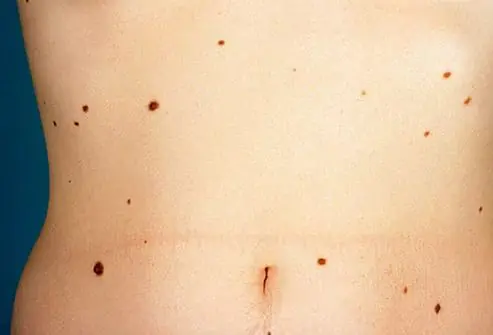
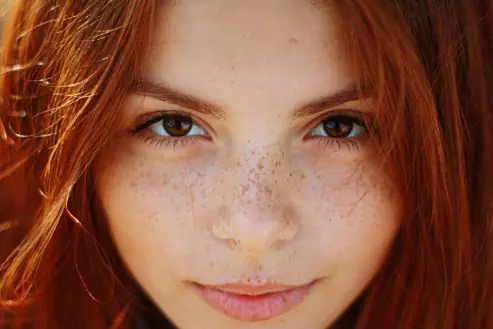
Freckles are flat spots that, like a tan, are slightly reddish or light brown in color. And they usually appear with the onset of sunny months. They are most common in people with fair skin. Many people with blond or red hair and green or blue eyes are more prone to these types of skin spots. Avoiding direct sunlight and using sun protection, including regular use of sunscreen, can suppress the appearance of some types of moles and freckles.
Are children born with moles?
Yes. Moles may be present at birth or gradually appear later in the postpartum period. Many children continue to develop moles into their teens and young adulthood. But they grow very weakly relative to the overall growth of the body. Congenital moles are already present at birth and form during fetal development. Other moles may appear later, as a result of factors that are not genetic but environmental, such as sun exposure.
Can new moles appear in adults?
Yes. Although many moles appear in the first years of life, the total number of moles usually peaks in the second or third decade of life, with an average age of 35. People no longer develop new moles after the age of 30. But adults often develop pigmented spots and growths such as freckles, lentigines, liver spots, and areas of seborrheic keratoses.
What else could it be
There are many skin growths that look like moles or freckles, such as:
- Lentigo,
- liver spots,
- Seborrheic keratosis,
- Melanoma,
- Neurofibroma,
- Hemangioma,
- Skin scars
- Dyes ingrained into the skin
- Pigmented cancerous basal cells, etc.
The best way to differentiate between these and other growths is to consult a dermatologist. Sometimes moles may appear near or on top of another skin lesion, such as a freckle or seborrheic keratosis. When in doubt, a skin biopsy can be very helpful in diagnosis. Therefore, in case of the slightest suspicion, immediately go to a specialist. Remember that malignant skin tumors develop at lightning speed and are practically not treated in advanced stages. Therefore, you cannot waste time, not even a single day!



